Ultimate White Texas Sheet Cake Recipe: Fluffy, Moist & Ready in Under an Hour
Prepare to fall in love with the ultimate White Texas Sheet Cake – a timeless classic renowned for its unbelievably tender crumb and irresistible, made-from-scratch fluffy frosting. This recipe delivers a generous 12 servings, making it perfect for family gatherings, potlucks, or simply satisfying a sudden craving for a truly delightful homemade cake. What truly sets this recipe apart is its incredible speed; you can have this exquisite dessert ready to enjoy in less than an hour! Forget waiting for butter to soften to room temperature, as the unique pourable icing method eliminates that step, setting beautifully as the cake cools.
Why You’ll Love This Easy Homemade Sheet Cake
There are countless reasons why this White Texas Sheet Cake has become a beloved staple in many kitchens. Its simplicity combined with exceptional flavor makes it an instant favorite. Unlike many elaborate cake recipes, this sheet cake is designed for minimal fuss without compromising on taste or texture. The secret lies in the unique preparation method, where the butter and water are brought to a boil before being combined with the dry ingredients, resulting in an incredibly moist and rich batter.
- Effortless Preparation: This recipe streamlines the baking process. The “no room temperature butter” hack is a game-changer, allowing you to whip up the batter without the usual waiting game. From mixing bowl to oven, this cake comes together quickly, perfect for busy schedules.
- Decadent Pourable Frosting: The frosting is truly a star. It’s prepared while the cake is still warm, then generously poured over the hot cake. This technique allows the creamy, sweet icing to slightly melt into the cake, creating a delicious, cohesive layer that’s utterly divine. As it cools, the frosting sets to a perfect, soft consistency that complements the cake’s tenderness.
- Perfectly Moist & Fluffy: Every bite reveals a delicate, fluffy cake with a supremely tender crumb. The inclusion of sour cream in the batter, even though you don’t taste it directly, is key to achieving this remarkable moisture and fine texture. The contrast between the soft cake and the smooth, creamy frosting is simply heavenly.
- Versatile for Any Occasion: Its classic white base makes it incredibly adaptable. Whether you’re celebrating a birthday, a holiday, or just enjoying a casual weekend, this cake fits right in. You can easily customize it with different sprinkles, fruit toppings, or even a dash of food coloring to match your theme.
- Feeds a Crowd: Baked in a large sheet pan, this recipe is designed to yield ample servings, making it ideal for larger gatherings. No need to bake multiple smaller cakes when one magnificent sheet cake will do the trick!
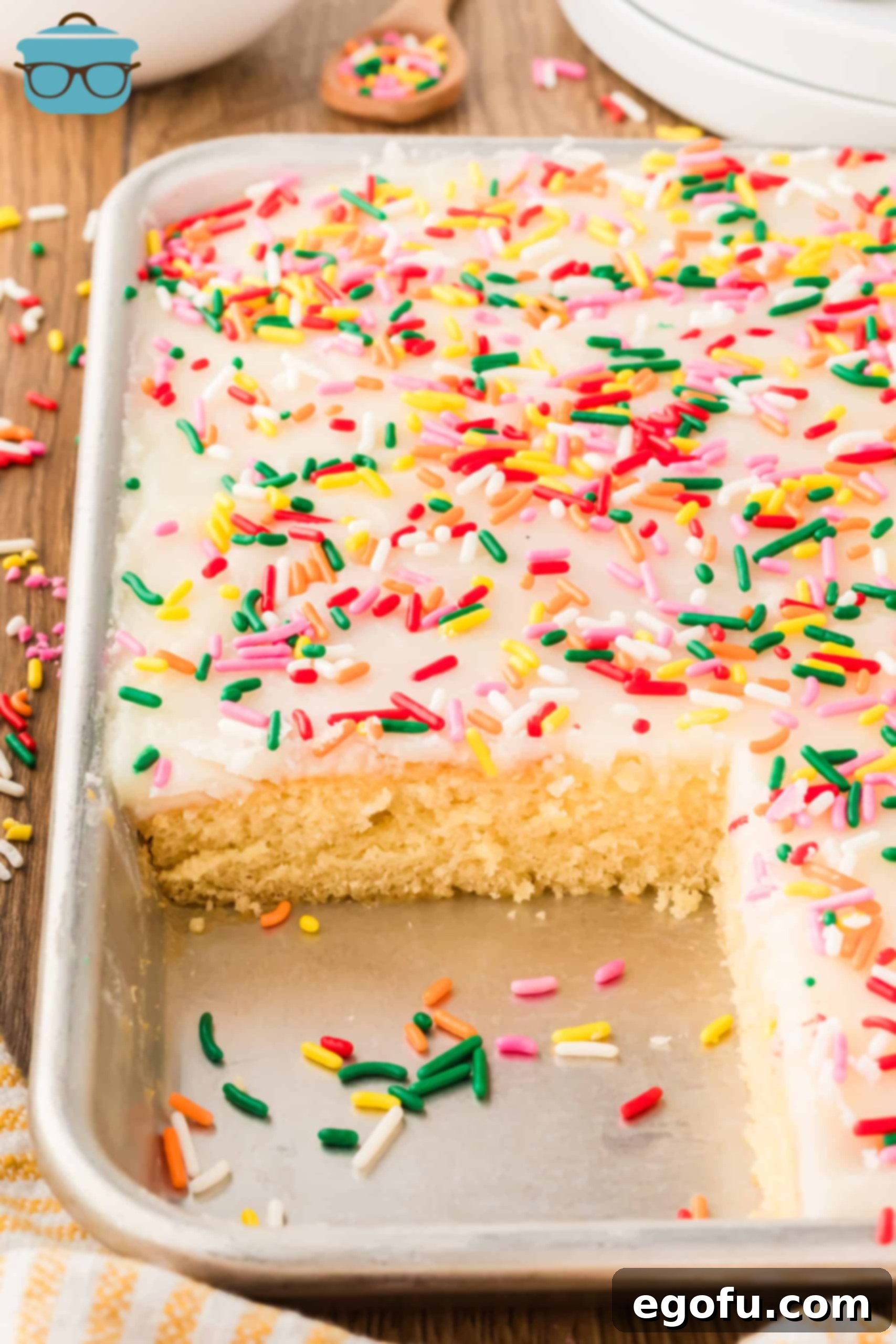

AMAZING AND DELICIOUS! Thanks so much!
– Andrea
Frequently Asked Questions About White Texas Sheet Cake
What size sheet pan do I use?
For this recipe, I primarily use a 13×18-inch sheet pan, often referred to as a half sheet pan. This size yields a cake with the perfect thickness and ensures even baking. Alternatively, a 11×15-inch jelly roll pan can also be used. If opting for the smaller jelly roll pan, your cake will naturally be a bit thicker. This means you might need to extend the baking time by a few extra minutes to ensure it’s fully cooked through. Always rely on the toothpick test for accuracy, as oven temperatures can vary.
Can I make this with cake mix?
Absolutely! While nothing beats a scratch-made cake, a good quality white cake mix can be a fantastic shortcut for this Texas Sheet Cake. For best results, I recommend using a Duncan Hines White Cake Mix. However, for that homemade taste and texture, you’ll want to slightly adjust the box instructions. Instead of following the package directions, beat 3 egg whites until they are frothy, then combine them with the dry cake mix in a mixing bowl. Next, incorporate ½ cup of melted salted butter (if using unsalted, add a pinch of salt to the mix), ¾ cup of milk, and a teaspoon of almond extract for an enhanced flavor. Mix thoroughly until just combined, pour into your prepared pan, and bake as directed on the cake mix box. Proceed with the homemade icing as usual.
Can I make this without a sheet cake pan?
Yes, you can certainly adapt this recipe for a standard 9×13-inch baking pan. When using a smaller pan, it’s crucial not to overfill it. The batter should only come about ¾ of the way up the sides of the pan to prevent overflow during baking. Due to the increased thickness of the cake in a smaller pan, you will need to adjust your baking times. Start checking for doneness around the 20-minute mark by inserting a toothpick into the center of the cake. If the toothpick comes out clean, the cake is done. If it still has wet batter clinging to it, continue baking in 5-minute increments until it passes the test. Keep a close eye on it to prevent overbaking and a dry cake.
How do I store leftover Texas Sheet Cake?
For optimal freshness and moisture, any leftover White Texas Sheet Cake should be stored at room temperature. Place it in an airtight container or cover it tightly with plastic wrap or aluminum foil. This method will keep the cake moist and delicious for up to 3 days. I generally advise against refrigerating homemade cakes because the cold air tends to dry them out much faster, diminishing their tender texture. If you need to store the cake for a longer period, it freezes wonderfully. Wrap individual slices tightly in plastic wrap, then again in aluminum foil, and they will keep well in the freezer for up to 3 months. Just be aware that freezing can sometimes subtly alter the texture, and prolonged freezing might lead to a slightly drier cake.

Essential Ingredients for Your White Texas Sheet Cake
Gathering the right ingredients is the first step to baking a truly exceptional White Texas Sheet Cake. Each component plays a crucial role in achieving the desired flavor and texture. Here’s a detailed look at what you’ll need:
- Unsalted Butter: The foundation of both the cake and the frosting, unsalted butter allows you to control the overall saltiness of the recipe. If you only have salted butter on hand, simply omit any additional salt called for in the recipe to avoid an overly salty taste.
- Water: Used in the unique “boiling method” for the cake batter, water combines with the butter to create a hot liquid base that ensures a tender and moist crumb.
- All-Purpose Flour: The primary structural component of the cake. For best results, measure your flour by spooning it into a measuring cup and then leveling it off with a straight edge. If using self-rising flour, remember to omit the additional baking soda listed in the recipe, as it’s already included in self-rising varieties.
- Granulated Sugar: Provides sweetness and contributes to the cake’s moistness and tender texture. For those managing sugar intake, a 1:1 sugar substitute can be used as a direct replacement without significantly altering the results.
- Salt: A small amount of regular table salt is essential to balance the sweetness and enhance all the other flavors in the cake and frosting.
- Baking Soda: This leavening agent is critical for the cake’s light and fluffy texture. Always ensure your baking soda is fresh for optimal rise. To test its freshness, add ¼ teaspoon of baking soda to a cup and pour in 2 teaspoons of vinegar. If it fizzes vigorously, it’s still good. If there’s little to no bubbling, it’s time for a new box.
- Large Eggs: Eggs add richness, structure, and help bind the ingredients together. For a smoother, more evenly mixed batter, try to bring your eggs to room temperature before adding them. Room temperature eggs emulsify better with other ingredients.
- Almond Extract: This gives the White Texas Sheet Cake its signature delicate and slightly nutty flavor. It can be easily replaced with an equal amount of vanilla extract if you prefer a more traditional flavor profile. The recipe has been tested and works beautifully with both.
- Sour Cream: A secret ingredient for an incredibly moist cake! Sour cream adds richness and moisture without making the cake taste tangy. Its subtle acidity also reacts with the baking soda to create a more tender crumb. If you don’t have it, you can omit it, but note that the cake may not be quite as moist.
- Milk: Adds moisture and helps thin the batter to the right consistency. Both the milk and sour cream can be replaced with an equal amount of buttermilk if you desire a tangier flavor and even more tender crumb.
- Powdered Sugar: The key ingredient for the smooth, pourable frosting. While many bakers swear by sifting powdered sugar to prevent lumps, I’ve personally found it unnecessary for this recipe, as the warm butter and milk in the frosting help dissolve any small clumps. However, feel free to sift if it’s part of your baking routine.
- Sprinkles: An optional but highly recommended addition for a fun, festive touch! Colorful sprinkles add visual appeal and a slight textural contrast to the soft frosting.

Step-by-Step Guide: Crafting Your Perfect White Texas Sheet Cake
Baking this White Texas Sheet Cake is a straightforward process that yields impressive results. Follow these steps carefully to ensure a perfectly moist cake with a delightful pourable frosting.
Preparing the Cake Batter:
Begin by preheating your oven to 375 degrees F (190 degrees C). Generously butter (or spray with nonstick cooking spray) your chosen baking pan—either a 13×18-inch half sheet pan or a 10×15-inch jelly roll pan. In a large mixing bowl, whisk together the dry ingredients: all-purpose flour, granulated sugar, salt, and baking soda. Make sure they are well combined, then set this mixture aside.
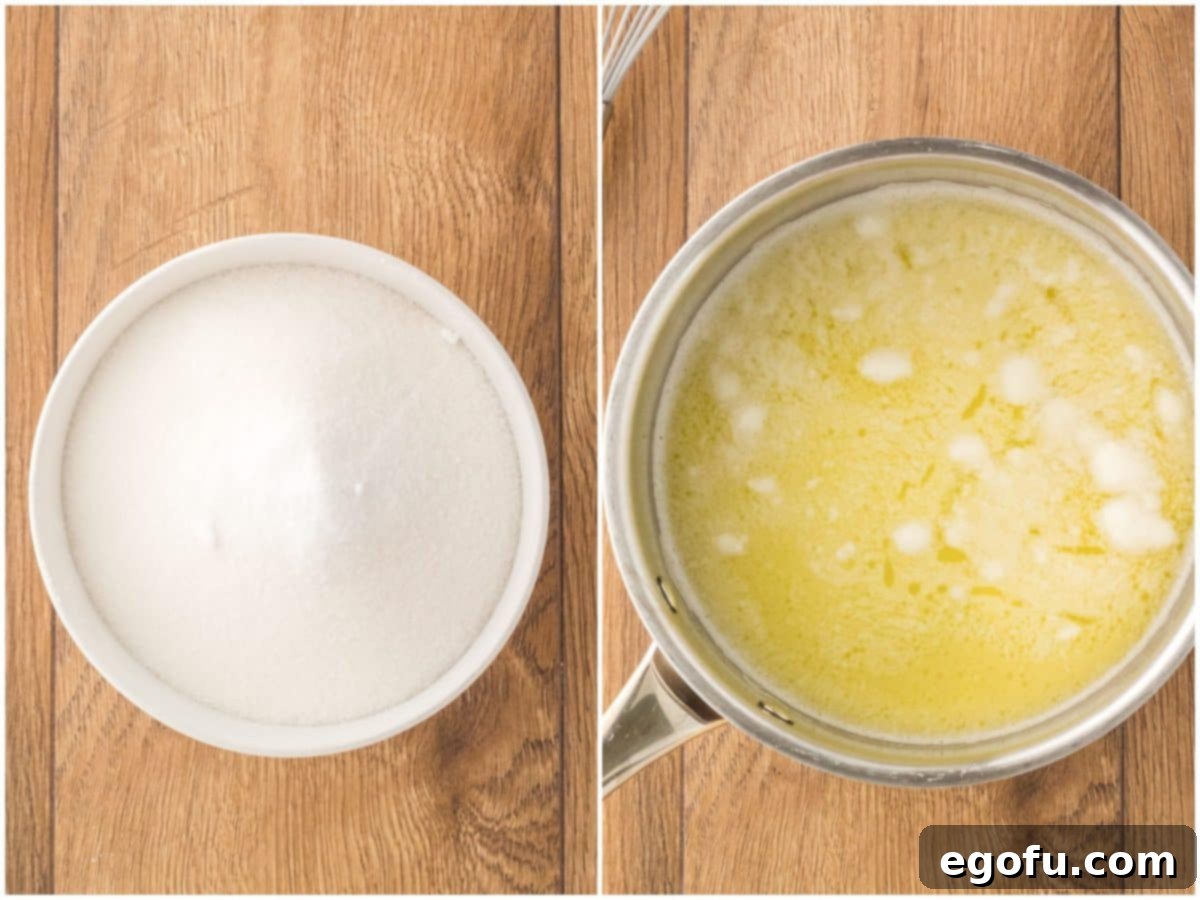
Next, in a large saucepan, combine the unsalted butter and water. Bring this mixture to a gentle boil over medium heat. As soon as it reaches a rolling boil, immediately remove the saucepan from the heat. This boiling liquid is a signature technique for many Texas Sheet Cake recipes, creating a rich and moist base for the batter.
Carefully pour the hot butter-water mixture into your bowl of dry ingredients. Mix everything thoroughly with a whisk or spoon, ensuring there are no dry pockets of flour and any clumps are smoothed out. Allow this batter to cool for about 5 to 10 minutes. This cooling period is crucial; it prevents the eggs, which will be added next, from curdling due to the heat.
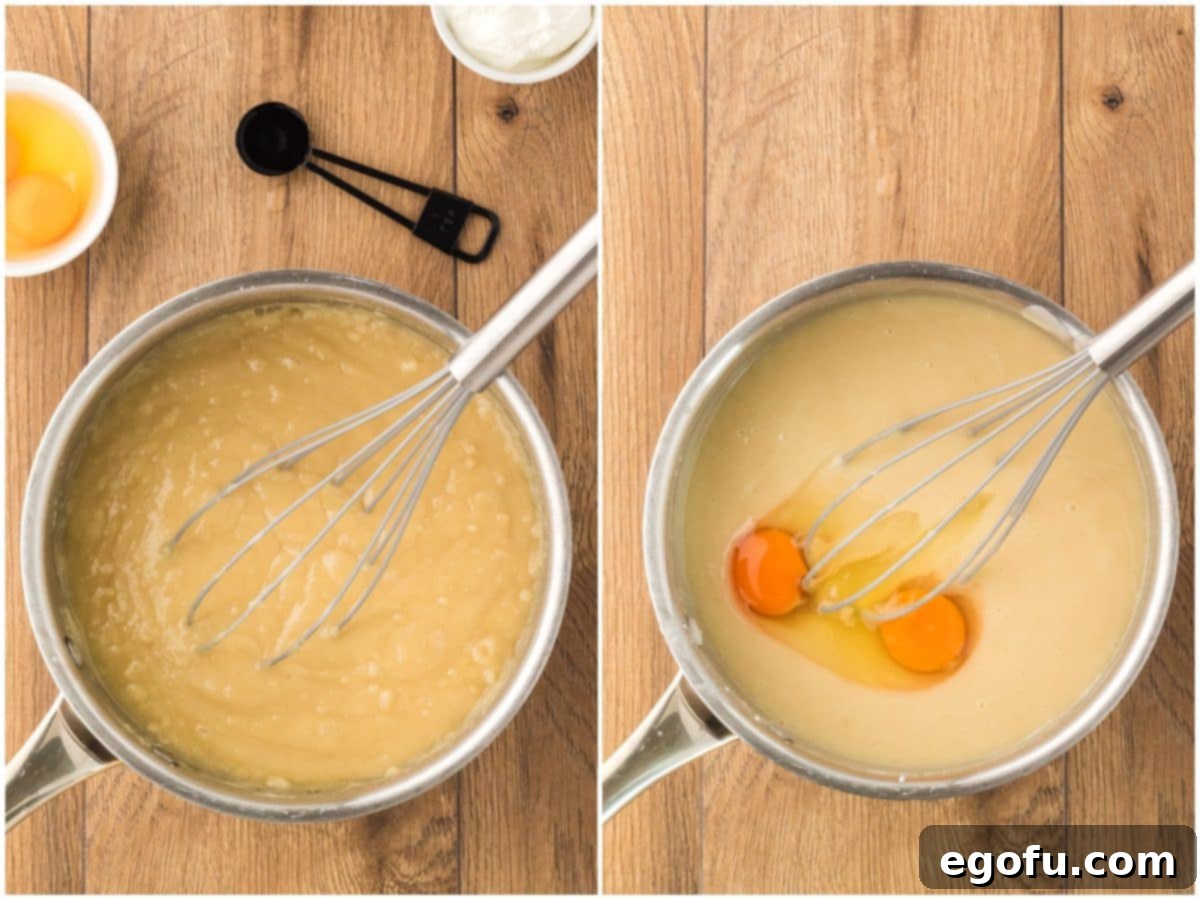
Once the batter has cooled slightly, stir in the almond extract, sour cream, and milk until these ingredients are thoroughly integrated. Finally, add the large eggs, mixing just until they are fully incorporated into the batter. Be careful not to overmix at this stage; overmixing can develop gluten too much, leading to a tougher cake.
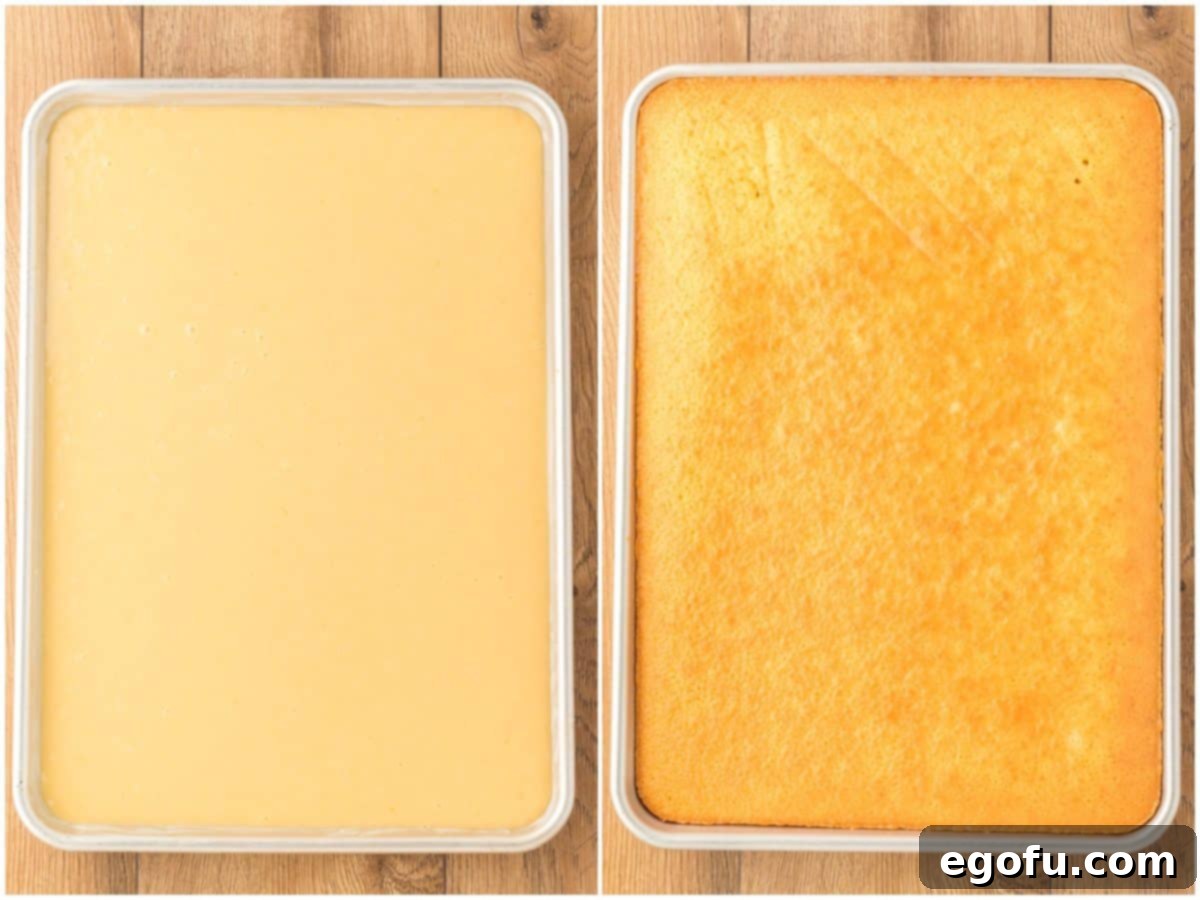
Pour the prepared batter evenly into your buttered sheet pan. Transfer the pan to the preheated oven and bake for approximately 20 minutes. The exact baking time may vary based on your oven and pan size. If you’re using the smaller 10×15-inch jelly roll pan, start checking for doneness around the 17-minute mark. The cake is done when a wooden toothpick inserted into the center comes out clean, with no wet batter attached.
Master the Frosting: Achieving that Signature Creamy Glaze
While the cake is baking, or immediately after it comes out of the oven, prepare the iconic pourable frosting. This frosting is meant to be warm when applied to the warm cake, creating a seamless, creamy layer that slightly soaks into the cake for an extra moist finish.
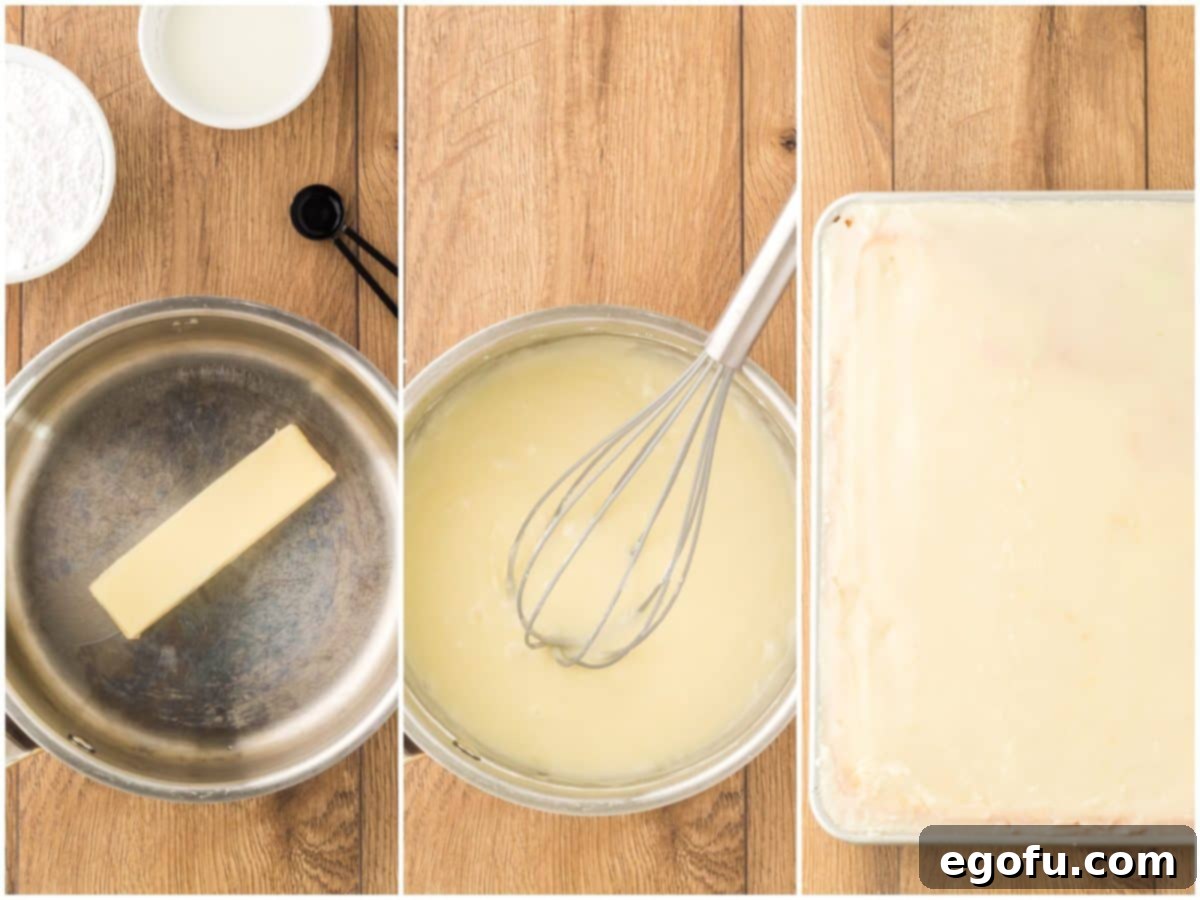
Remove the baked cake from the oven and place the pan on a wire rack to cool for about 15 minutes. During this time, in a clean saucepan, melt the unsalted butter over medium heat. Once the butter is fully melted, remove the pan from the heat and whisk in the powdered sugar, milk, and almond extract. Continue whisking until the sugar is completely dissolved and the icing is smooth and free of lumps. It should have a glossy, pourable consistency.
Generously pour the warm icing evenly over the still-warm cake. The warmth of both the cake and the frosting allows the icing to spread smoothly and lightly seep into the top layer of the cake, creating that signature moist texture. If desired, immediately top with colorful sprinkles for a festive look. Allow the cake to cool completely before slicing and serving. As it cools, the frosting will set to a beautiful, soft glaze.

More Delicious Sheet Cake & Dessert Recipes to Explore
If you loved this White Texas Sheet Cake, you’re in for a treat! Our collection features a variety of other delightful cake recipes that are just as easy and satisfying. Expand your baking repertoire with these fan favorites:
- Classic Texas Sheet Cake
- Rich Chocolate Sheet Cake
- Traditional Homemade White Cake
- Comforting Homemade Yellow Cake
- Simple One Bowl Homemade Chocolate Cake
- Bright Homemade Lemon Layered Cake
- Festive Homemade Funfetti Cake
- Light and Airy Homemade Angel Food Cake
- Hearty Homemade Pound Cake
- Delicious Homemade Double Crumb Cake
- Moist Homemade Banana Cake
- Sweet Cinnamon Roll Cake
- Refreshing Fresh Strawberry Cake

White Texas Sheet Cake
A simple homemade White Texas Sheet Cake with a fluffy made-from-scratch frosting that can serve up to a dozen and is ready in under an hour!
Pin Recipe
Rate This Recipe
- Prep Time:
- 30 minutes
- Cook Time:
- 20 minutes
- Total Time:
- 50 minutes
- Servings:
- 12 servings
- Author:
- Brandie Skibinski
Ingredients
For the Cake:
- 2 cups all-purpose flour
- 2 cups granulated sugar
- 1 teaspoon salt
- 1 teaspoon baking soda
- ½ cup (1 stick) unsalted butter
- 1 cup water
- 1 teaspoon almond extract
- ¼ cup sour cream
- ½ cup milk
- 2 large eggs
For the Icing:
- ½ cup (1 stick) unsalted butter
- 3 cups powdered sugar
- 6 Tablespoons milk
- ½ teaspoon almond extract
- sprinkles (optional)
Instructions
- Pre-heat the oven to 375 degrees F (190°C). Butter (or spray with nonstick cooking spray) a half sheet pan (13×18-inches) or a jelly roll pan (10×15-inches).
- Combine 2 cups all-purpose flour, 2 cups granulated sugar, 1 teaspoon salt, and 1 teaspoon baking soda in a mixing bowl. Set it aside.
- In a large saucepan, add ½ cup (1 stick) unsalted butter and 1 cup water. Bring to a gentle boil and immediately remove from the heat.
- Mix the flour mixture into the hot water and butter. Mix well, making sure to break up any clumps. Let cool for 5-10 minutes before moving to the next step. (This is important so that the eggs don’t curdle in the batter.)
- Stir in 1 teaspoon almond extract, ¼ cup sour cream, and ½ cup milk. After this is mixed thoroughly, add in 2 large eggs.
- Pour batter into the prepared sheet pan.
- Bake for about 20 minutes (until a toothpick comes out clean). If using the smaller jelly roll pan (10×15-inch), check at about the 17-minute mark.
- Remove the cake from the oven and place the pan on a wire rack to cool for about 15 minutes while you make the icing.
Icing Instructions:
- In a saucepan, melt ½ cup (1 stick) unsalted butter over medium heat.
- Add in 3 cups powdered sugar, 6 Tablespoons milk, and ½ teaspoon almond extract. Whisk together and cook until the sugar is well incorporated and the icing is smooth.
- Pour the warm icing over the warm cake.
- Top with sprinkles, if desired.
Video
Notes
- Please refer to the FAQ section and detailed ingredient list above for other substitutions or for answers to the most common questions about this recipe.
- Course:
- Dessert
- Cuisine:
- American
Nutrition
- Calories: 487kcal
- Carbohydrates: 80g
- Protein: 4g
- Fat: 18g
- Sodium: 309mg
- Fiber: 1g
- Sugar: 64g
Nutritional Disclaimer: The nutritional information provided is an estimate. It is not provided by a registered dietician or nutritionist. Calorie counts and other nutritional values can vary significantly depending on specific brands used and preparation methods. If precise nutritional values are important to you, we recommend calculating them using your preferred online nutritional calculator with the exact ingredients you use.
Did you make this recipe? Share it on Instagram @thecountrycook and mention us #thecountrycook!
